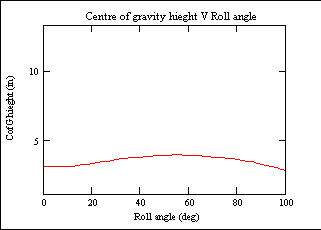I've been looking into craft stability recently as part of an on-going project, I thought that some of the conclusions might be of interest.
There are two stability cases, ie "on-cushion" and "off-cushion". Obviously on-cushion is normal operation, and off cushion is when floating without lift. Off cushion stability is critical, because should you suffer engine failure your craft is your life raft and you don't want it to turn over, no matter how rough the sea is.
There are two more things we need to get to grips with, ie dynamic stability and static stability.
Dynamic stability is how stable the craft is when operating at speed, ie if you are operating at a yaw close to 90 deg (side slipping) and you hit a wave, will the craft turn over? My craft capsized on the Severn because I exceeded its dynamic stability margin in high winds.
Static stability relates to stationary operation. If you are stationary, and a wave hits you, will the craft turn over? A GP Cruiser turned over in 2009 because it exceeded its static stability margin after broaching in rough surf. It's interesting that two seemingly similar events had different causes.
Off cushion stabilityStarting with off-cushion stability, the first thing we can say is that we're unlikely to be going very fast off-cushion so we can safely ignore the dynamic stability case, and talk about static stability.
Static stability is the ability of the craft to resist spontaneous rolling over, and is best expressed as a "roll over angle" - this being the angle to which the craft may be tipped, in water, before it will roll right over. The rollover angle can be calculated - it takes a bit of doing (I programmed the computer to do it for me) but results in the plot shown below. This is for my Surveyor, with a relatively high (14") centre of gravity.

Figure 1 Surveyor roll-over curve
The Surveyor rollover curve shows that the centre of gravity must rise about 8.5 inches and the craft roll to 74 degrees before it before it will roll over. That's pretty good in my estimation, and practically speaking, you can walk about on the sides of the craft when off cushion and it feels pretty stable.
We can contrast that to a "Challenger" style craft with flooded plenum and no added buoyancy in the plenum - not a craft we're likely to see on the open water I'm pleased to say! Lets say the designer done a good job and got the centre of gravity down to 8 inches. The rollover curve is also shown below, notice how flat the curve is.

Figure 2 - Challenger rollover curve (8" CG)
This tells us that the craft would have poor stability despite its low centre of gravity, it would rollover at 58 degrees with very little provocation. Even worse, if the designer had put a bigger engine in and the centre of gravity was say 12", then the rollover curve does not go up at all. This means this craft would just rollover even sitting in a flat calm pond!

Figure 3 - Challenger rollover curve (12" CG)
So how does the Surveyor maintain stability with an even higher centre of gravity? The credit for this goes to the designer and the skirt system, which needs no plenum. The result is a dry plenum that provides extra buoyancy as the craft is tipped over, lifting the centre of gravity and giving the stability that is required.
In order to correct the stability problem with the Challenger style craft, additional buoyancy has to be provided in the plenum, and is best attached to the plough planes as far out as possible. This is seen in many traditional wet plenum craft.
On cushion stabilityOn cushion stability is a different case, and I'll cover that later...